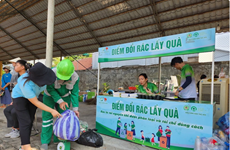Mekong Delta formulates environmental plan
Provinces in the Mekong Delta are taking steps to address urgent
environmental issues by developing urban zoning plans and improving
human resource training.
Provinces in the Mekong Delta are taking steps to address urgent
environmental issues by developing urban zoning plans and improving
human resource training.
Upgrading of technical infrastructure, especially of forecasting and inspection equipment, is another top priority, the Southwestern Department for Environmental Protection has said.
Water pollution in the delta, as well as a general degradation of the environment, is occurring at an alarming rate, according to a survey conducted by the Water Resources University.
The survey said that E. coli bacteria in rivers and canals in the region had exceeded the permitted level.
To enhance cooperation among localities, Delta officials also plan to organise more forums on environmental protection.
In addition, local water-supply and drainage systems will be upgraded in an effort to prevent flooding in urban areas.
New waste collection and treatment facilities will be built, and environmental inspection will be strengthened in localities, industrial parks and manufacturing and trading establishments.
To help companies pay for upgrading waste water treatment systems in industrial parks, local authorities have issued policies to offer them financial support.
Every year, about 3.7 million tonnes of solid waste in the region, mostly untreated, is released in rivers and canals.
Industry emissions and activities in the delta have also contributed to higher levels of pollution, including noise pollution.
Suspended solids and ammonia nitrogen (NH3-N), as well as ammoniac and coliform content in rivers and canals in the provinces of An Giang, Vinh Long, Long An, Hau Giang and Ca Mau and Can Tho City are all higher than the permitted levels.
The concentration of nitrogen dioxide (NO2), sulphur dioxide (SO2) and carbon monoxide (CO) in the air in the region's urban areas is also higher than standard levels, according to the Water Resources University's survey.-VNA
Upgrading of technical infrastructure, especially of forecasting and inspection equipment, is another top priority, the Southwestern Department for Environmental Protection has said.
Water pollution in the delta, as well as a general degradation of the environment, is occurring at an alarming rate, according to a survey conducted by the Water Resources University.
The survey said that E. coli bacteria in rivers and canals in the region had exceeded the permitted level.
To enhance cooperation among localities, Delta officials also plan to organise more forums on environmental protection.
In addition, local water-supply and drainage systems will be upgraded in an effort to prevent flooding in urban areas.
New waste collection and treatment facilities will be built, and environmental inspection will be strengthened in localities, industrial parks and manufacturing and trading establishments.
To help companies pay for upgrading waste water treatment systems in industrial parks, local authorities have issued policies to offer them financial support.
Every year, about 3.7 million tonnes of solid waste in the region, mostly untreated, is released in rivers and canals.
Industry emissions and activities in the delta have also contributed to higher levels of pollution, including noise pollution.
Suspended solids and ammonia nitrogen (NH3-N), as well as ammoniac and coliform content in rivers and canals in the provinces of An Giang, Vinh Long, Long An, Hau Giang and Ca Mau and Can Tho City are all higher than the permitted levels.
The concentration of nitrogen dioxide (NO2), sulphur dioxide (SO2) and carbon monoxide (CO) in the air in the region's urban areas is also higher than standard levels, according to the Water Resources University's survey.-VNA













